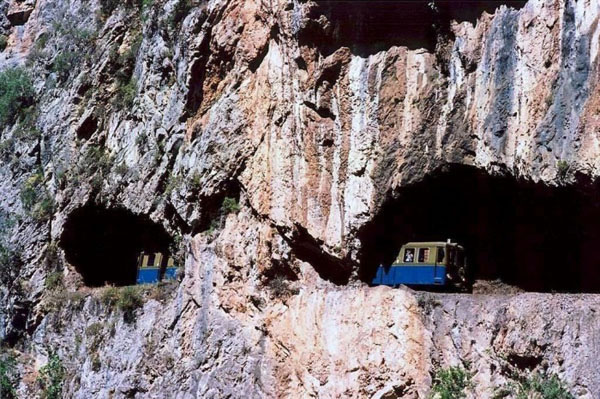A case of couleur locale
Peloponnese in Southern Greece features one of the most spectacular rack trains in the world, “Odontotos”. The short route connects a seashore town (Diakofto) with the mountainous Kalavryta plateau (700m altitude), up and through the impressive Vouraikos Gorge. Visited it for the first time recently. I kind of knew that railways were built in 1880s/90s? Something like that. The relatively young Greece acquired the large Thessalia flatland in the north at the time, putting integration via transport into perspective. Government was frantically trying to develop inter/ intra-national trade routes and at the same time bring forth a late to the party industrial mojo. Railway became a smoking symbol of this endeavor.
The initial expansion from Athens to the Peloponnese makes sense: Apart from the obvious pros (accessibility, speed, safety, mass character, for natives and visitors alike) of the railway, there were some major ports and established trade houses there, while agricultural production was also of note. The rails formed a curve around the northern/ western coastal line of Peloponnese and cut through its mainland in the southern/ eastern sides, in order to form a ring of sorts:

This is the 1882 plan, which mostly went through. The network was constructed in a “regular” manner, albeit with rails less wide than the international standard ‘cause cost, including cities, towns, ports and a couple of special sites (i.e., Olympia). And then we have the green-circled outcrop, the rack rail. The recent trip there left me perplexed. Why decide to undertake such a difficult task in rugged terrain, that needed expertise and special rails (different from those of the rest)?
Surely, Kalavryta was (and still is) a place of national significance. The Greek Revolution of 1821 is said to have started at a monastery (Agia Lavra) there, where the local Metropolitan blessed the gathered leaders of the upcoming war. A celebratory 1896 edition, on the occasion of the first modern Olympic Games (hosted in Athens that year), even chronicles the Peloponnese railway saga. Regarding the rack train, it references the exquisite natural environment, Agia Lavra and another historical monastery as good reasons to give it a ride. Fair enough, but still somewhat vague. What else was there that made that region stand out from the others? Here the rationale gets a step up.

Kalavryta was home to a wealthy, powerful family. It happened that a member of the family served as Member of Parliament when the railway project was on fire. This man persuaded the PM of the vital role a railway connection was to play in the development of the surrounding areas. Provided that a scion of the same family serves in the current Greek Parliament, too, this “local interest cuddling” reasoning gets some traction, in my view.
Even if the decision was just that, local patronizing, it still held some more rational economic – political water: Back then, the cost of sending wheat from the (fertile) plateau down to sea level was twice as high the cost of shipping said wheat from fucking Russia to Greece (compare 22km to, dunno, 2200km). And why not just import the dang thing then? Well, Greece had had the “honor” to be at the receiving end of a naval pacific blockade by the era’s great forces in 1886, so it perhaps had reached the conclusion that food security was something to be pursued.

The rack train project was initiated by law in 1889 and (after absorbing 3x the envisaged cost plus 5x the scheduled time of completion, effectively cutting short any ideas of expanding it further towards Tripoli) began its inaugural journey in, well, 1896.
It turns out that the whole railway affair was overhyped and demand for train services did not to really stretch that far to meet supply, not to mention the appearance of competitive means of transport (steamboats and roads). The rack train, however, remained the sole anchor of reliable transport till the 1970s, when roads proper were built. In the meantime, it also became a traveler’s sensation, too, confirming the positive light that celebratory book shone on it 120+ years before.